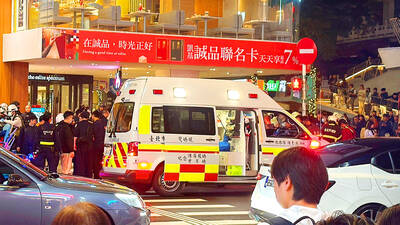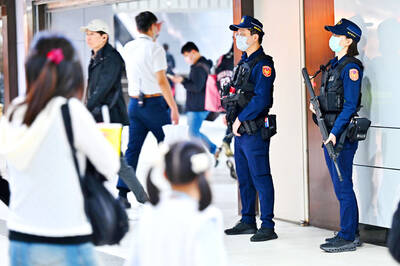China’s massive military buildup will “complicate” US options should China attack Taiwan, US-China Economic and Security Review Commission chairman Dennis Shea said on Thursday.
Beijing’s greatly increased military capabilities could impact the potential for US intervention, he said.
China will “increasingly challenge” US ability to deter regional conflicts, defend longtime regional allies and partners, and maintain open and secure access in the Asia Pacific, the commission’s annual report to the US Congress said.
“The broad build up of Chinese military capabilities would certainly complicate a US intervention in the case of an attack in a Taiwan scenario,” Shea said at a meeting called to release the report.
He said the commission had always shown “very strong” support for Taiwan and for the sale of US weapons to ensure the nation could meet its self-defense needs.
However, he said it was clear that the military balance had shifted significantly in favor of China.
“A strong Taiwan helps maintain stability across the Taiwan Strait and the US should ensure that Taiwan has what it needs for defense,” commissioner Peter Brookes said.
The commission hoped to “raise the profile” of the situation and make [the] US Congress aware of Taiwan’s security needs, commissioner Katherine Tobin said.
There is “tremendous unease” throughout the region, she said.
China was altering the military balance of power in the Asia-Pacific region in ways that could exacerbate regional hotspots such as Taiwan, the report said.
The US would need to quickly and safely deploy military forces across great distances during a regional conflict, it said.
Taiwan is about 11,265km from San Diego.
“China’s large-scale cybercampaign against the US could further impede US wartime operations,” the report said.
According to the report, China now maintains the largest and most-lethal short-range ballistic missile force in the world, and all of the missiles — about 1,200 of them — could strike targets throughout Taiwan.
“During a conflict with Taiwan, China likely would use its short-range ballistic missiles to strike critical military infrastructure, and command and control nodes, as well as key political and economic centers,” the report said.
It said that China would likely fire large salvos from multiple directions to “confuse, overwhelm and exhaust” the nation’s ballistic missile defenses.
The report said that China’s ballistic and cruise missiles have the potential to provide the People’s Liberation Army with a decisive military advantage in a regional conflict.
“China now is able to threaten US bases and operating areas throughout the Asia Pacific, including those that it previously could not reach with conventional weapons, such as US forces on Guam,” the report said.
“China’s nuclear force will rapidly expand and modernize over the next five years, providing Beijing with a more extensive range of military and foreign policy options and potentially weakening US extended deterrence, particularly with respect to Japan,” it added.

TRAGEDY STRIKES TAIPEI: The suspect died after falling off a building after he threw smoke grenades into Taipei Main Station and went on a killing spree in Zhongshan A 27-year-old suspect allegedly threw smoke grenades in Taipei Main Station and then proceeded to Zhongshan MRT Station in a random killing spree that resulted in the death of the suspect and two other civilians, and seven injured, including one in critical condition, as of press time last night. The suspect, identified as a man surnamed Chang Wen (張文), allegedly began the attack at Taipei Main Station, the Taipei Fire Department said, adding that it received a report at 5:24pm that smoke grenades had been thrown in the station. One man in his 50s was rushed to hospital after a cardiac arrest

A car bomb killed a senior Russian general in southern Moscow yesterday morning, the latest high-profile army figure to be blown up in a blast that came just hours after Russian and Ukrainian delegates held separate talks in Miami on a plan to end the war. Kyiv has not commented on the incident, but Russian investigators said they were probing whether the blast was “linked” to “Ukrainian special forces.” The attack was similar to other assassinations of generals and pro-war figures that have either been claimed, or are widely believed to have been orchestrated, by Ukraine. Russian Lieutenant General Fanil Sarvarov, 56, head

SAFETY FIRST: Double the number of police were deployed at the Taipei Marathon, while other cities released plans to bolster public event safety Authorities across Taiwan have stepped up security measures ahead of Christmas and New Year events, following a knife and smoke bomb attack in Taipei on Friday that left four people dead and 11 injured. In a bid to prevent potential copycat incidents, police deployments have been expanded for large gatherings, transport hubs, and other crowded public spaces, according to official statements from police and city authorities. Taipei Mayor Chiang Wan-an (蔣萬安) said the city has “comprehensively raised security readiness” in crowded areas, increased police deployments with armed officers, and intensified patrols during weekends and nighttime hours. For large-scale events, security checkpoints and explosives

PUBLIC SAFETY: The premier said that security would be tightened in transport hubs, while President Lai commended the public for their bravery The government is to deploy more police, including rapid response units, in crowded public areas to ensure a swift response to any threats, President William Lai (賴清德) said yesterday after a knife attack killed three people and injured 11 in Taipei the previous day. Lai made the remarks following a briefing by the National Police Agency on the progress of the investigation, saying that the attack underscored the importance of cooperation in public security between the central and local governments. The attack unfolded in the early evening on Friday around Taipei Main Station’s M7 exit and later near the Taipei MRT’s Zhongshan